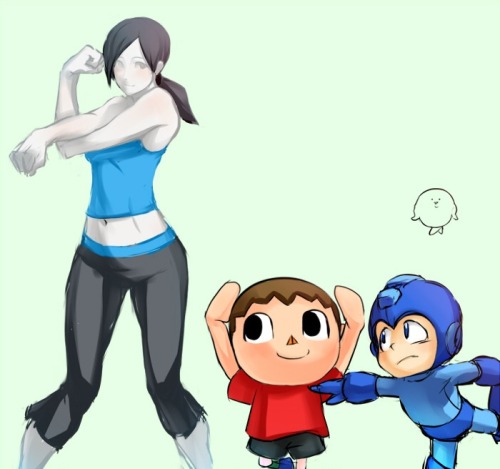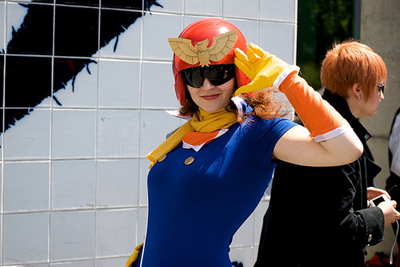Thou Shalt Smash (Finally)
The first thing I noticed tuning into the starting matchup of Mario VS Kirby was that they were playing on the Paper Mario stage. Not the Omega Form one either - the moving, dynamic, and frankly dangerous one. Very much a This Is Not Evo kind of stage. It's really four or five stages, taking the players through an epic journey, winding up in Bowser's Castle, one of the most unforgiving play areas imaginable. Then a Smash Ball appeared and well... shit got real.Turns out, the rules for the first two rounds (Top 16 and Top 8) of the tournament were as follows:
- Single Elimination
- Random Stage, No Omega Form
- Character Customisation Allowed
- All Special move variants
- Limited Equipment (only stat boosts, no Start-With-Item stuff. They didn't say exactly what the limitations were)
- No Items, Except Smash Ball.
- 6 minutes per mach
These are not rules we'd see in a community-organised event like Evo or The Big House. Typically, Smash tournaments have striven to be as even as possible, making skill the deciding factor. No items, few if any stages with hazards of any kind, and character customisation is new to SSB4. This is a bold statement from Nintendo: our game, our rules. I respect that attitude. They built this game knowing there was going to be a competitive following. They are aware of the intense skill to be found among their fans. With these rules, they are challenging those players to learn everything about the game - not just For Glory mode.
Allowing character customisation was something that surprised me a bit, but I mean, why not? It's there, and it adds a lot of complexity to the game. Megaman becomes a much different character if his Side B is a freeze ray and his Neutral B explodes all but himself.
As a point of interest, the rules for the Top 4:
- Single Elimination
- Random Stage, No Omega Form
- Character Customisation Allowed (same as top 16/8)
- No Smash Ball
- 6 minutes per match
And the finals:
- Best 2 out of 3
- Random Stage, ONLY Omega Form
- Character Customisation
- Same as before, and player can alter their customisation between games
- No Items
- No Time Limit
So, the rules do level out to something you'd expect from a high level Melee tournament, notwithstanding character customisation. Luck can carry you to the finals, but not to the prize. One (of three) Rosalina & Luma player, Dabuz, got Jungle Japes for his first two rounds, a stage which is advantageous for the character. If he didn't deserve those victories, we'd know it by the finals - but he 2-0'd his opponent to win, proving his worth.
This kind of rules design is something Nintendo has been doing with Pokémon for years. The Pokémon Championships have different rules each year, restricting Pokémon choice, item use, battle format (usually Doubles), and move selection, fostering creativity by limiting options. With Smash, the opposite is true: they're limiting dominant strategies by rewarding familiarity with all the game's elements. It's not enough to say "I'll play Little Mac because he's the best on Final D." If you aren't prepared for other stages, you won't make it through to the end.
New Tech For A New Era
The Top 16 character representation was a healthy mix of new and old characters, and each was unique (even among ostensibly identical picks).
The characters were:
- Kirby
- Captain Falcon
- Ganondorf
- Fox
- Zelda
- Robin
- Little Mac
- Samus
- Yoshi x 2
- Mario x 3
- Rosalina & Luma x 3
The finals were, as statistics would dictate is the most likely outcome, Mario VS Rosalina. Notably missing from this array: Sonic, Duck Hunt, Pikachu, Meta Knight, Sheik, Marth, Link, Olimar, Pit, R.O.B., Villager, Pac-Man... all characters I've heard people call top-tier in past or present. "Top Tier" may be a thing of the past; with so many characters being viable, it will come down to which characters counter the most popular choices, and therefore, who has the bigger roster.
Rosalina & Luma were the grand winners of this tournament, and there were 3 in the top 16 (2 in the top 4!). The next step for you, O Community, is to come up with a counter to the puppet character, which is a new concept in Smash. So, the tech war begins....
This has made me more excited than I anticipated for future grand tournaments of Smash. Mew2King and ZeRo have been spending a lot of time in the game, analysing characters, practising. Armada has declared he wants to be the first world champion of the game. Dabuz, who won this tournament, was a big player in the Brawl scene. This game is taking players from all iterations of Smash, and who knows what will happen as a result?
Until next time...
Stay excited, Star-Shooter.
-mysteriosum(the deranged hermit)















